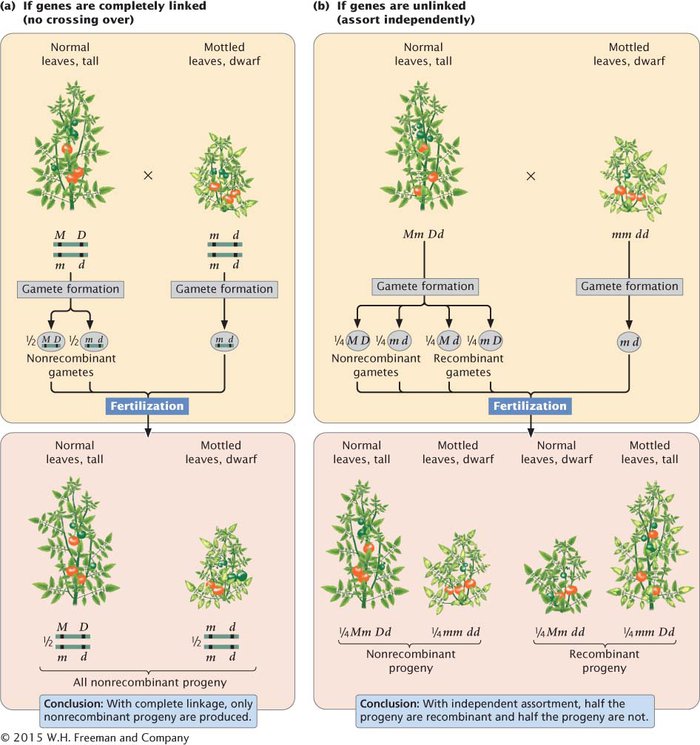Complete Linkage Compared with Independent Assortment
We will first consider what happens to genes that exhibit complete linkage, meaning that they are located very close together on the same chromosome and do not exhibit crossing over. Genes are rarely completely linked, but by assuming that no crossing over takes place, we can see the effect of linkage more clearly. We will then consider what happens when genes assort independently. Finally, we will consider the results obtained if the genes are linked but exhibit some crossing over.
A testcross reveals the effects of linkage. For example, if a heterozygous individual is test-
119
Consider a pair of linked genes in tomato plants. One of the genes affects the type of leaf: an allele for mottled leaves (m) is recessive to an allele that produces normal leaves (M). Nearby on the same chromosome, the other gene determines the height of the plant: an allele for dwarf (d) is recessive to an allele for tall (D).
Testing for linkage can be done with a testcross, which requires a plant that is heterozygous for both characteristics. A geneticist might produce this heterozygous plant by crossing a variety of tomato that is homozygous for normal leaves and tall height with a variety that is homozygous for mottled leaves and dwarf height:

The geneticist would then use this F1 heterozygote in a testcross, crossing it with a plant that is homozygous for mottled leaves and dwarf height:

The results of this testcross are diagrammed in Figure 5.4a. The heterozygote produces two types of gametes: some with the M D chromosome and others with the m d chromosome. Because no crossing over takes place, these gametes are the only types produced by the heterozygote. Notice that these gametes contain only combinations of alleles that were present in the heterozygote’s parents (the plants in the P generation): either the allele for normal leaves together with the allele for tall height (M and D) or the allele for mottled leaves together with the allele for dwarf height (m and d). Gametes that contain only original combinations of alleles present in the parents are nonrecombinant gametes, or parental gametes.

120
The homozygous parent in the testcross produces only one type of gamete; it contains chromosome  and pairs with one of the two gametes generated by the heterozygous parent (see Figure 5.4a). Two types of progeny result: half have normal leaves and are tall:
and pairs with one of the two gametes generated by the heterozygous parent (see Figure 5.4a). Two types of progeny result: half have normal leaves and are tall:

and half have mottled leaves and are dwarf:

These progeny display the original combinations of traits present in the P generation and are nonrecombinant progeny, or parental progeny. No new combinations of the two traits, such as normal leaves with dwarf height or mottled leaves with tall height, appear in the offspring, because the genes affecting the two traits are completely linked and are inherited together. New combinations of traits could arise only if the physical connection between M and D or between m and d were broken.
These results are distinctly different from the results that are expected when genes assort independently (Figure 5.4b). If the M and D loci assorted independently, the heterozygous plant (Mm Dd) would produce four types of gametes: two nonrecombinant gametes containing the original combinations of alleles (M D and m d) and two gametes containing new combinations of alleles (M d and m D). Gametes with new combinations of alleles are called recombinant gametes. With independent assortment, nonrecombinant and recombinant gametes are produced in equal proportions. These four types of gametes join with the single type of gamete produced by the homozygous parent of the testcross to produce four kinds of progeny in equal proportions (see Figure 5.4b). The progeny with new combinations of traits formed from recombinant gametes are termed recombinant progeny.
In summary, a testcross in which one of the plants is heterozygous for two completely linked genes yields two types of progeny, each type displaying one of the original combinations of traits present in the P generation. In contrast, independent assortment produces progeny in a 1 : 1 : 1 : 1 ratio. That is, there are four types of progeny: two types of recombinant progeny and two types of nonrecombinant progeny in equal proportions.